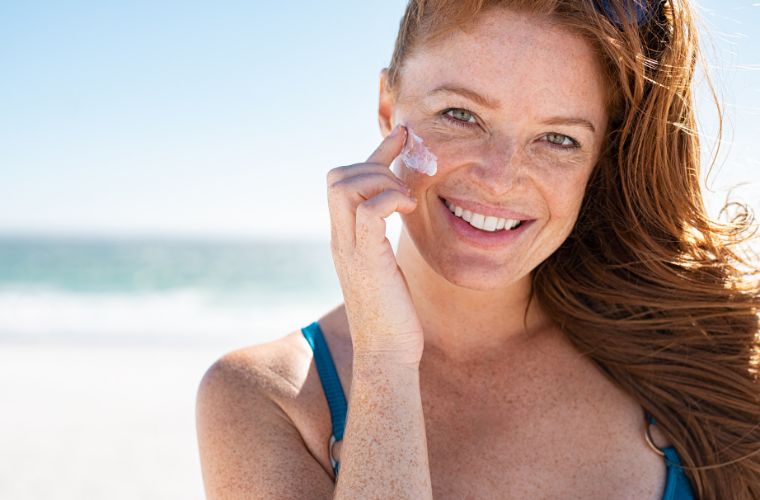The ABCs of SPF: Making Sun Safety a Priority This Summer

With summer around the corner, more people will be participating in outdoor activities like going to the beach, riding bikes, playing tennis or gardening. It’s important to always protect yourself from the sun’s rays with an effective sunscreen product. Sunscreen absorbs or reflects ultraviolet (UV) rays from the sun, which can cause skin cancer and premature aging.
The acronym SPF stands for sun protection factor, a relative measurement for the amount of time the sunscreen will protect you from UV rays. UVB rays primarily affect the epidermis, the outer layer of the skin. The American Cancer Society recommends using a broad-spectrum sunscreen with an SPF of at least 30, which blocks 97% of the sun’s rays.
“No matter what your age, sunscreen is one of the best and easiest ways to protect your skin,” said BayCare’s VP/Chief Quality Officer Dr. Laura Arline, MD, FACP, FAAP. “On sunny and even cloudy days, our skin is susceptible to the sun’s rays. Apply a broad-spectrum sunscreen with an SPF of 30 or higher before outdoor activities, and reapply after swimming, using a towel, and after being outdoors for extended periods of time. Make sure to see a healthcare provider if you notice any changes in your skin or new spots.”
Practicing sun safety and protecting yourself from the sun’s harmful rays is as easy as ABC.
Apply regularly. It’s a good rule of thumb to re-apply your sunscreen every two hours, or more frequently if you’ve been in the water.
Broad spectrum. Broad spectrum SPF refers to sunscreens that protect the skin from both UVA and UVB rays.
Cover up. When you’re out in the sun, wear clothing and a wide-brimmed hat to protect as much skin as possible. Protect your eyes with sunglasses that block at least 99% of UV light.
Dates are important. Most bottles have an expiration date — and for good reason. Old sunblock may not work as well as a fresh tube because the chemical formulas can change over time, especially with exposure to sunlight and heat.
Everyone needs sunscreen. While it may be true that lighter skin tones burn easier, damage can still happen without causing a red, blistering sunburn. Apply sunscreen regardless of how dark or light your skin tone is.
Find shade. The sun’s rays are strongest between 10 a.m. and 2 p.m. If your shadow is shorter than you are, seek shade.
Go green. If protecting the environment is just as important to you as protecting your skin, you can find a variety of zero waste sunscreen brands that are also reef-safe and won’t affect the fertility of marine life.
History. Sunscreen first appeared on the market in the late 1960s, but it wasn’t until around 1972 that labeling of SPF was introduced in the U.S.
Invest in scalp and hair sunscreen. The skin on your scalp is just as susceptible to burns and damage as the rest of your skin. If you have a distinct hair part or you’re bald, apply sunscreen to the area.
Just a minute. How long does it take for your skin to burn without sunscreen? If you wear SPF 30, for example, it should take 30 times longer to burn than if you weren’t wearing sunscreen.
Know the facts. Sunscreen is a ‘screen’ and not a ‘block’ and will never block 100% UV radiation. It is still possible to receive a dose of UV radiation high enough to cause skin damage while wearing sunscreen.
Lips need sunscreen, too! The FDA recommends applying sunscreen on all uncovered skin, including your lips, nose, ears, neck, hands, feet and hairline.
Melanoma. The most serious type of skin cancer that develops in the cells (melanocytes) that produce melanin — the pigment that gives your skin its color.
No time like the present. The Skin Cancer Foundation recommends everyone wear sunscreen, and babies can start wearing it as early as six months old.
Overcast days call for sunscreen, too! Just because the sun is hiding behind the clouds doesn’t mean it’s not there. Up to 80% of UV rays can get through to your skin. You can still burn, so treat it like any other sunny day and check the UV Index and wear SPF.
Perfume at night only. When sprayed directly onto the skin, perfume can undermine the skin’s ability to protect itself against UV damage and makes it more vulnerable to sun damage. That means the level of protection you get from your sunscreen is diminished as well. Avoid it during the day, if possible.
Quarter of a teaspoon. You need a generous ¼ teaspoon of sunscreen for your face, the front of your neck, your ears and the little space behind your ears in front of your hairline. Use more if you have a high forehead or large face. To be safe, aim for between ¼ and ½ teaspoon of sunscreen for your face, neck and ears.
Rays at higher altitudes. If you’re skiing, UV rays are even more intense at higher altitudes as up to 80% gets reflected off its surface. Even when the temperatures get chilly, use a broad spectrum SPF 30.
Skin cancer. According to the U.S. Department of Health and Human Services, nearly five million people are treated for skin cancer every year.
Two types of SPF sunscreens — chemical and physical. Both types prevent the sun’s rays from entering the skin, each just uses different ingredients. Physical SPFs have either titanium or zinc while chemical SPFs contain elements like oxybenzone, avobenzone and octinoxate.
Ultraviolet rays. The most damaging of the sun’s rays to our skin are ultraviolet (UV) rays. There are two basic types of ultraviolet rays that reach the earth’s surface—UVA and UVB.
Vitamin D. Your body gets vitamin D when sunlight hits the skin. While theoretically, wearing sunscreen can lower vitamin D levels, most people get their recommended dose through food, or doing simple tasks outdoors.
Waterproof sunscreen. Waterproof, baby or sport sunscreens don’t exist. No sunscreen is waterproof or sweatproof (at least, not yet).
X factor. Sunscreen is one of the most important items in your beach tote, pool bag or travel backpack.
You should be wearing sunscreen every day. Dermatologists recommend you use sunscreen every day while you’re outdoors.
Zinc oxide. One of the biggest benefits to using zinc oxide sunscreen is that it’s ideal for those with sensitive skin. If you have eczema or another inflammatory skin condition, a zinc oxide sunscreen may be your best bet for sun protection.
So, whether you are spending your time in the Florida sun this summer, or traveling on a vacation, don’t forget that sun safety is essential for everyone.


